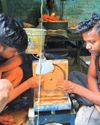World of the gazer

BIRDWATCHING IS not an eternal quest for rarity, though no birder denies the thrill of sighting one. It is not about racing all over the landscape and tallying a century of birds before lunch, though no birder will deny the special joy of such a 'ton'. It is not twitching for the greatest number of species seen, though there have been many that have basked in the sunshine of that self-indulgent high life (they truly miss the wood for the trees).
Birdwatching, in its essence, is the fine art of becoming invisible-of merging into the surroundings in such a way that the breath which nature has held back upon your entry into its parlour is joyfully exhaled and normal respiration restored; in such a way that the frozen statues of animate wildlife, interrupted by your brashness, are coaxed into resuming their activities; in such a way that your aural and visual senses are drenched with the buoyancy of life; in such a way that you find a way outside yourself and become a part of the pageant around you.
This does require the cultivation of a patience that slows down your pace to that of the elemental cycles dominating the flow of life in an immaculate world run entirely without human help. It requires the marshalling and realigning of vision and a new focus of hearing so that you absorb every single sound and identify its source and gradually its nuances, its cadenzas. It demands a preoccupation with stillness.
What are the rewards of this exercise? I can think of at least two that will last you a lifetime. One, you will begin to notice things about your surroundings that you never knew existed, bringing you immediate, immeasurable joy. Two, your restless inner dynamo will wind down to such an extent that you discover a quietude, a stillness within you; a fount for a fresh view of your surroundings, a new approach to life based on reenergized sensitivities.
Bu hikaye Down To Earth dergisinin August 16, 2023 sayısından alınmıştır.
Start your 7-day Magzter GOLD free trial to access thousands of curated premium stories, and 9,500+ magazines and newspapers.
Already a subscriber ? Giriş Yap
Bu hikaye Down To Earth dergisinin August 16, 2023 sayısından alınmıştır.
Start your 7-day Magzter GOLD free trial to access thousands of curated premium stories, and 9,500+ magazines and newspapers.
Already a subscriber? Giriş Yap

Reluctant to share
Even three decades after panchayats received constitutional status, states across India seem unwilling to share power with them

GET THE BALANCE RIGHT
India currently relies on three major food crops—rice, maize and sugarcane—for ethanol production. Ethanol-blended petrol supports the country’s goals of carbon neutrality and energy sovereignty. But the transition to clean energy must not jeopardise food security.
Brazil outbreak triggers poultry export bans
A TOTAL of 24 governments, including India, China, South Africa and the EU, announced a complete ban on poultry products from Brazil by the end of May, after the Latin American country confirmed an outbreak of avian influenza.

TRICKY TRAJECTORY
Indirect emissions from land-use changes, overexploitation of water resources must not be ignored in the pursuit of biofuel

MIND THE TRADE-OFF
In times of climate change, a careful roadmap must be drawn to plan how much of food crops can be diverted to fuel production

May mayhem
The 2025 monsoon arrived a week early and raced across India in May, breaking records with its speed and intensity

LOST IN MAIZE
Ethanol-blending programme and its spiralling impacts on food inflation, nutrition availability

World at risk of losing ice sheet, glaciars
THE ANTARCTIC ice sheet, which has the biggest potential for sea-level rise upon melting, may be at or very close to a tipping point, says a study published in Communications Earth and Environment on May 30.

Artwork by nature
Once close to disappearance, Banda's shajar stone handicraft industry is on a revival path

World at risk of losing ice sheet, glaciars
THE ANTARCTIC ice sheet, which has the biggest potential for sea-level rise upon melting, may be at or very close to a tipping point, says a study published in Communications Earth and Environment on May 30.
